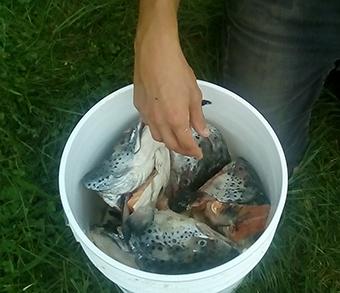Zero Waste & the Fish Heads: Making Fertilizer on the Farm
Using sugar and 20 pounds of fish heads procured by Mt. Airy Meat & Fish Manager Dale Kinley, we’re making our own fish fertilizer this season at Weavers Way’s farm at Awbury Arboretum.
As part of our effort to reduce expenses and limit our reliance on commercial fertilizers, we’re experimenting with making our own inputs from simple materials that are available cheaply or for free, either harvested from the wild or taken from other businesses’ waste. (Seafood wholesaler Samuels & Son was happy to unload the salmon heads on Dale for 25 cents a pound.)
Earlier in the year, we made a foliar spray from giant knotweed, that invasive bane of local parks and roadsides. This plant is used in Chinese medicine for its anti-fungal properties, and when sprayed on leaves, may have a similar immune-system-activating effect on our crops.
Organic farmers use liquid fish fertilizer to provide plants a shot of nitrogen, which is needed for leaf development. We water our transplants with it before setting them out in the field, and sometimes use it as a foliar spray on more mature plants if we see their leaves yellowing.
We got the idea to make our own fish fertilizer from Adrian Galbraith-Paul, another urban farmer who works at Heritage Farm in West Philadelphia. Adrian follows many of the principles of Korean Natural Farming, or KNF, a synthesis of techniques that Korean peasant farmers have developed over generations. KNF centers on the idea of introducing beneficial microbial life and nutrients through natural inputs like forest soil, eggshells and fish heads.
Another aspect of KNF is that all of its recipes are simple and quick. To make our fish fertilizer, we filled three 5-gallon buckets with alternating layers of fish heads and sugar, and then inoculated the mixture with some forest soil that Adrian gave us. That’s it!
The sugar will draw the moisture out of the fish and discourage the growth of bad bacteria and fungus, while the good bacteria in the forest soil will spread through the brew and slowly break down the fish. In three to six months, we will open the buckets and expect to find a dark golden, sweet-smelling liquid, similar to the fish sauce you may find in a Korean restaurant. After straining out the bones, we can store it at room temperature and it should last us for our whole 2019 season!

